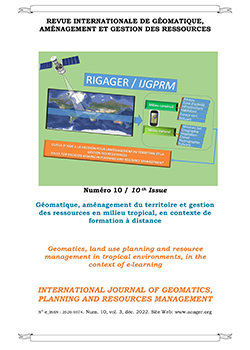
Dynamique spatio-temporelle de l’occupation du sol dans le Parc national du Mont Cameroun et sa périphérie (Région du Sud –Ouest Cameroun), entre 1986 et 2020
Année de Publication: 2022
Auteurs: Mezafack Karol L., Tata Juluis N., Kana colins, Momo Solefack, Masango Sone
Résumé
Le mont Cameroun (4095 m d’altitude), en raison de son contexte spécifique de diversité biologique, fait partie des parcs nationaux du
Cameroun, La fertilité légendaire des sols du volcan attire depuis des siècles une mosaïque de populations. En effet, classés dans la catégorie II de l’Union internationale pour la conservation de la nature (UICN) un espace attrayant dont les ressources génèrent les convoitises, c’est aussi une zone où la croissance urbaine et le développement des plantations agroindustrielles spécifiquement dans sa partie occidentale sont à l’origine de la conversion du couvert végétal originel. Afin de réduire la pression humaine sur ce paysage, l’une des étapes phares est de retracer l’historique de la couverture du sol; d’où l’objectif général de cette étude est d’analyser la dynamique spatio temporelle de l’occupation du sol dans ladite zone. L’approche méthodologique s’est basée sur une approche cartographie basée sur l’analyse des images Landsat multi date (1986, 2010 et 2020), utilisant la méthode de classification basée sur l’algorithme de maximum de vraisemblance. Le traitement d’images a permis de mettre en évidence les
changements observés sur onze classes d’occupation sol entre 1986 et 2020.
De plus, l’élaboration d’une matrice de transition entre les différentes formes d’occupation du sol à différentes dates s’est avérée nécessaire pour identifier les tendances de conversion des terres. Le résultat a révélé qu’une transformation significative de l’utilisation des terres et de la couverture
végétale s’est produite au cours de ces années. Les transformations se sont opérées de façon différentielles en effet, des régressions ont été observées au niveau des formations forestières naturelles (forêts littorales, forêts sub montagnardes et les mangroves, respectivement de l’ordre de -30,28 %, –
14,33 % et -38,37% de la totalité de la zone d’étude) au profit de l’espace bâti et des plantations agricoles qui à leurs tours connaissent des taux d’évolution respectifs de 33,94 % et 13, 49 %. A l’inverse, on peut noter d’importantes progressions des surfaces occupées par les forêts secondaires jeunes et les forêts denses de montagne, due à l’effort de conservation et à la reprise végétale sur d’anciennes coulées de laves. Des mesures spatialement ciblées s’imposent pour ce hot-spot de la biodiversité au Cameroun.
Cameroun, La fertilité légendaire des sols du volcan attire depuis des siècles une mosaïque de populations. En effet, classés dans la catégorie II de l’Union internationale pour la conservation de la nature (UICN) un espace attrayant dont les ressources génèrent les convoitises, c’est aussi une zone où la croissance urbaine et le développement des plantations agroindustrielles spécifiquement dans sa partie occidentale sont à l’origine de la conversion du couvert végétal originel. Afin de réduire la pression humaine sur ce paysage, l’une des étapes phares est de retracer l’historique de la couverture du sol; d’où l’objectif général de cette étude est d’analyser la dynamique spatio temporelle de l’occupation du sol dans ladite zone. L’approche méthodologique s’est basée sur une approche cartographie basée sur l’analyse des images Landsat multi date (1986, 2010 et 2020), utilisant la méthode de classification basée sur l’algorithme de maximum de vraisemblance. Le traitement d’images a permis de mettre en évidence les
changements observés sur onze classes d’occupation sol entre 1986 et 2020.
De plus, l’élaboration d’une matrice de transition entre les différentes formes d’occupation du sol à différentes dates s’est avérée nécessaire pour identifier les tendances de conversion des terres. Le résultat a révélé qu’une transformation significative de l’utilisation des terres et de la couverture
végétale s’est produite au cours de ces années. Les transformations se sont opérées de façon différentielles en effet, des régressions ont été observées au niveau des formations forestières naturelles (forêts littorales, forêts sub montagnardes et les mangroves, respectivement de l’ordre de -30,28 %, –
14,33 % et -38,37% de la totalité de la zone d’étude) au profit de l’espace bâti et des plantations agricoles qui à leurs tours connaissent des taux d’évolution respectifs de 33,94 % et 13, 49 %. A l’inverse, on peut noter d’importantes progressions des surfaces occupées par les forêts secondaires jeunes et les forêts denses de montagne, due à l’effort de conservation et à la reprise végétale sur d’anciennes coulées de laves. Des mesures spatialement ciblées s’imposent pour ce hot-spot de la biodiversité au Cameroun.
